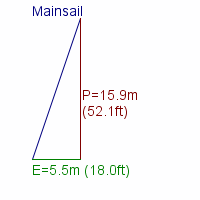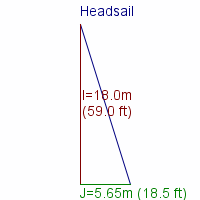Review of Hallberg-Rassy 46

Basic specs.

If you have a photo you would like to share: Upload Image
Looking for a new boat? Find a Hallberg-Rassy 46 or similar boat for sale
The hull is made of fibreglass. Generally, a hull made of fibreglass requires only a minimum of maintenance during the sailing season.
The boat is equipped with 8 berths and 920.0 liter fresh water capacity.
The Hallberg-Rassy 46 is equipped with a masthead rig. The advantage of a masthead rig is its simplicity and the fact that a given sail area - compared with a fractional rig - can be carried lower and thus with less heeling moment.
Fin keel
The Hallberg-Rassy 46 is equipped with a fin keel. A boat with a fin keel is more manoeuvrable but has less directional stability than a similar boat with a full keel.
The keel is made of lead. Compared with iron, lead has the advantage of being 44% heavier, which allows a smaller keel and hence less water resistance and higher speed.
The boat can only enter major marinas as the draft is about 1.88 - 1.98 meter (6.17 - 6.47 ft) dependent on the load. See immersion rate below.
The Hallberg-Rassy 46 has been equipped with different engine alternatives.
Alternative 1:
Hallberg-Rassy 46 may be equipped with a Yamaha 4LH-TE engine at 110 hp (81 kW). The speed is 8.5 knots..
Alternative 2:
The boat may be equipped with an inboard Volvo Penta TMD 31 diesel engine at 95 hp (70 kW).
The fuel tank has a capacity of 660.0 liters (174 US gallons, 145 imperial gallons).
Sailing characteristics
This section covers widely used rules of thumb to describe the sailing characteristics. Please note that even though the calculations are correct, the interpretation of the results might not be valid for extreme boats.
What is Capsize Screening Formula (CSF)?
The capsize screening value for Hallberg-Rassy 46 is 1.74, indicating that this boat could - if evaluated by this formula alone - be accepted to participate in ocean races.
The immersion rate is defined as the weight required to sink the boat a certain level.
The immersion rate for Hallberg-Rassy 46 is about 430 kg/cm, alternatively 2412 lbs/inch.
Meaning: if you load 430 kg cargo on the boat then it will sink 1 cm.
Alternatively, if you load 2412 lbs cargo on the boat it will sink 1 inch.
Sailing statistics
This section is statistical comparison with similar boats of the same category. The basis of the following statistical computations is our unique database with more than 26,000 different boat types and 350,000 data points.
What is L/B (Length Beam Ratio)?
The l/b ratio for Hallberg-Rassy 46 is 3.40.
The ballast ratio for Hallberg-Rassy 46 is 41%.
What is SA/D (Sail Area Displacement ratio)?
The SA/D for Hallberg-Rassy 46 with ISO 8666 reference sail is 15.1, with a 135% genua the SA/D is 18.0.
Don't panic! It is expected that motor sailers has a low SA/D value as this is the natural consequence of the design combining sailing and motor boat characteristics.
Maintenance
Dimensions of sail for masthead rig.


Are your sails worn out? You might find your next sail here: Sails for Sale
If you need to renew parts of your running rig and is not quite sure of the dimensions, you may find the estimates computed below useful.
| Usage | Length | Diameter | ||
| Mainsail halyard | 41.0 m | (134.7 feet) | 14 mm | (0.55 inch) |
| Jib/genoa halyard | 41.0 m | (134.7 feet) | 14 mm | (0.55 inch) |
| Spinnaker halyard | 41.0 m | (134.7 feet) | 14 mm | (0.55 inch) |
| Jib sheet | 14.8 m | (48.5 feet) | 16 mm | (5/8 inch) |
| Genoa sheet | 14.8 m | (48.5 feet) | 16 mm | (5/8 inch) |
| Mainsheet | 36.9 m | (121.2 feet) | 16 mm | (5/8 inch) |
| Spinnaker sheet | 32.5 m | (106.7 feet) | 16 mm | (5/8 inch) |
| Cunningham | 5.5 m | (18.0 feet) | 14 mm | (0.55 inch) |
| Kickingstrap | 11.0 m | (36.1 feet) | 14 mm | (0.55 inch) |
| Clew-outhaul | 11.0 m | (36.1 feet) | 14 mm | (0.55 inch) |
This section is reserved boat owner's modifications, improvements, etc. Here you might find (or contribute with) inspiration for your boat.
Do you have changes/improvements you would like to share? Upload a photo and describe what you have done.
We are always looking for new photos. If you can contribute with photos for Hallberg-Rassy 46 it would be a great help.
If you have any comments to the review, improvement suggestions, or the like, feel free to contact us. Criticism helps us to improve.
